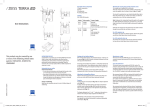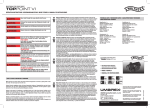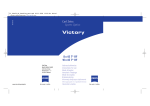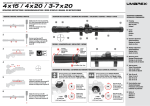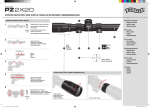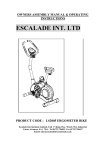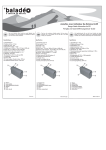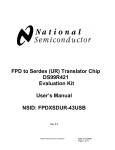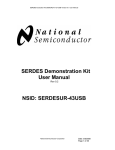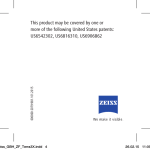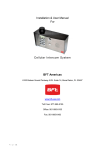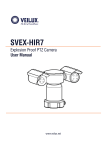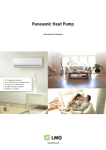Download Victory
Transcript
01_V8x45T_RF_Umschlag_pant.qxd 30.05.2011 10:41 Uhr Seite 1 1763-003/05.09 902790 ZEISS_01 V8x45T*RF_Umschlag_pant.qxd / S. 1 / Pantone Reflex Blue / Schwarz Carl Zeiss Sports Optics Victory “This product may be covered by one or more of the following United States patents: US6542302, US6816310, US6906862” Carl Zeiss Sports Optics GmbH Carl Zeiss Group Gloelstrasse 3 – 5 D-35576 Wetzlar www.zeiss.de/sportsoptics We make it visible. 8 x 45 T* RF / 10 x 45 T* RF 8 x 56 T* RF / 10 x 56 T* RF Gebrauchshinweise Instructions for use Mode d’emploi Istruzioni d‘impiego Mode de empleo Bruksanvisning Informacje dotyczące użytkowania Инструкция по применению Használati utasítás We make it visible. Bezeichnung der Bauteile / Part description 01_V8x45T_RF_Umschlag_pant.qxd 30.05.2011 10:41 Uhr Seite 1 1763-003/05.09 902790 ZEISS_01 V8x45T*RF_Umschlag_pant.qxd / S. 1 / Pantone Reflex Blue / Schwarz Carl Zeiss Sports Optics Victory “This product may be covered by one or more of the following United States patents: US6542302, US6816310, US6906862” Carl Zeiss Sports Optics GmbH Carl Zeiss Group Gloelstrasse 3 – 5 D-35576 Wetzlar www.zeiss.de/sportsoptics We make it visible. 8 x 45 T* RF / 10 x 45 T* RF 8 x 56 T* RF / 10 x 56 T* RF Gebrauchshinweise Instructions for use Mode d’emploi Istruzioni d‘impiego Mode de empleo Bruksanvisning Informacje dotyczące użytkowania Инструкция по применению Használati utasítás We make it visible. Bezeichnung der Bauteile / Part description 01_V8x45T_RF_Umschlag_pant.qxd 30.05.2011 10:41 Uhr Seite 2 902790 ZEISS_01 V8x45T*RF_Umschlag_pant.qxd / S. 2 / Cyan = Pantone Reflex Blue / Pantone Red 032C / Schwarz Bezeichnung der Bauteile / Part description 1 3 5 2 4 Gebrauchshinweise User Information Wir gratulieren Ihnen zu Ihrem neuen Fernglas mit eingebautem LaserEntfernungsmesser. FCC Class B Compliance Statement Die Produkte der Marke Carl Zeiss sind geprägt durch hervorragende optische Leistungen, präzise Verarbeitung und eine lange Lebensdauer. Bitte beachten Sie folgende Gebrauchshinweise, damit Sie Ihr Produkt optimal nutzen können und es Ihnen über viele Jahre ein zuverlässiger Begleiter wird. Achtung Schauen Sie keinesfalls mit dem Fernglas in die Sonne oder Laserlichtquellen. Dies könnte zu schweren Augenverletzungen führen und das Produkt kann erheblichen Schaden nehmen. 6 7 Setzen Sie das Gerät nicht ohne Schutzdeckel oder ohne Tasche längere Zeit der Sonne aus. Das Objektiv und das Okular können wie ein Brennglas wirken und innen liegende Bauteile zerstören. Fig. 1 Informationen für Ihre Sicherheit Batterie-Entsorgung Batterien gehören nicht in den Hausmüll! Bitte bedienen Sie sich bei der Rückgabe verbrauchter Batterien eines in Ihrem Land evtl. vorhandenen Rücknahmesystems. Bitte geben Sie nur entladene Batterien ab. Batterien sind in der Regel dann entladen, wenn das damit betriebene Gerät – abschaltet und signalisiert „Batterie leer“. – nach längerem Gebrauch der Batterie nicht mehr einwandfrei funktioniert. 8 Zur Kurzschlusssicherheit sollten die Batteriekontakte mit einem Klebestreifen überdeckt werden. Fig. 2 Deutschland: Als Verbraucher sind Sie gesetzlich verpflichtet, gebrauchte Batterien zurückzugeben. Sie können Ihre alten Batterien überall dort unentgeltlich abgeben, wo die Batterien gekauft wurden. Ebenso bei den öffentlichen Sammelstellen in Ihrer Stadt oder Gemeinde. Diese Zeichen finden Sie auf schadstoffhaltigen Batterien: Pb = Batterie enthält Blei Cd = Batterie enthält Cadmium Hg = Batterie enthält Quecksilber Li = Batterie enthält Lithium 9 10 Fig. 3 Fig. 4 1 2 Information to the User NOTE: This equipment has been tested and found to comply with the limits for a class B digital device, pursuant to Part 15 of the FCC Rules and meets all requirements of the Canadian Interference-Causing Equipment Regulations (ICES-003). These limits are designed to provide reasonable protection against harmful interference in a residential installation. This equipment generates, uses and can radiate radio frequency energy and, if not installed and used in accordance with the instructions, may cause harmful interference to radio communications. However, there is no guarantee that interference will not occur in a particular installation. If this equipment does cause harmful interference to radio or television reception, which can be determined by turning the equipment on and off, the user is encouraged to try to correct the interference by one or more of the following measures: ● Reorient or relocate the receiving antenna. ● Increase the separation between the equipment and receiver. ● Connect the equipment into an outlet on a circuit different from that to which the receiver is connected. ● Consult the dealer or an experienced radio/ TV technician for help. Carl Zeiss Sports Optics GmbH is not responsible for any radio or television interference caused by unauthorized modifications of this equipment or the substitution or attachment of connecting cables and equipment other than those specified by Carl Zeiss Sports Optics GmbH. The correction of interference caused by such unauthorized modification, substitution or attachment will be the responsibility of the user. The use of shielded I/O cables is required when connecting this equipment to any and all optional peripheral or host devices. Failure to do so may violate FCC and ICES rules. Instructions for use Congratulations on the purchase of your new binoculars with integrated laser range finder. Carl Zeiss brand products are characterised by outstanding optical performance, accurate processing and long durability. Please observe the following instructions for use, so that you enjoy optimum use of your product and it can be a faithful companion to you for many years. Caution Do not use the binoculars to look at the sun or at laser light sources. This could result in serious injury to the eyes and in considerable damage to the product. Do not expose the equipment to long periods in the sun without a protective cap or bag. The lens and the eyepiece can function like a magnifying glass and damage internal components. Information for your safety Battery disposal Do not dispose of batteries with household waste. Please use any existing return system in your local area when returning used batteries. Please only hand in discharged batteries. Batteries are generally discharged when the equipment operated with them: – switches off or indicates “battery empty” – the battery no longer functions correctly after an extended period in use. To prevent short circuits, cover the battery contacts with an adhesive strip. Germany: As a consumer, you have a legal obligation to return used batteries. You can hand in your batteries for free to wherever the batteries were purchased or to the public collection points in your city or community. You will find these symbols on batteries that contain harmful substances: Pb = Battery contains lead Cd = Battery contains cadmium Hg = Battery contains mercury Li = Battery contains lithium 16 Victory RF Caution Use only battery types recommended by the manufacturer. Handle used batteries in accordance with the manufacturer’s instructions. Under no circumstances should batteries be thrown into a fire, heated up, recharged, taken apart or broken open. User information for the disposal of electrical and electronic equipment (private households) This symbol on products and/or accompanying documents indicates that used electrical and electronic products are not to be mixed with ordinary household waste. Take these products to the appropriate collection point for proper handling, recovery and recycling, where they will be taken back for free. In some states, it may also be possible to hand in these products to your local dealer when purchasing a corresponding new product. The proper disposal of this product serves to protect the environment and prevents possible harmful effects on human beings and their surroundings, which may arise as a result of incorrect handling of waste. More detailed information on your nearest collection point is available from your local authority. According to state law, fines may be issued for the incorrect disposal of this type of waste. For business customers within the European Union To dispose of electrical and electronic equipment, please contact your dealer or supplier, who will be able to provide you with more information. Information on disposal in other countries outside of the European Union This symbol is applicable only in the European Union. Please contact your local authority or your dealer if you wish to dispose of this product and enquire about how to dispose of it. 17 Instructions for use Table of contents Identification of the components . . . . . . . . . . . . . . . . . . . . . . . . . . . . . . . . 18 Scope of delivery . . . . . . . . . . . . . . . . . . . . . . . . . . . . . . . . . . . . . . . . . . . 19 Preparation . . . . . . . . . . . . . . . . . . . . . . . . . . . . . . . . . . . . . . . . . . . . . . . . 19 Inserting/Removing the battery . . . . . . . . . . . . . . . . . . . . . . . . . . . . . . . . . . 19 Attaching the carrying strap and the protective caps . . . . . . . . . . . . . . . . . 20 Observation with and without glasses . . . . . . . . . . . . . . . . . . . . . . . . . . . . . 21 Cleaning and replacing the eye cups . . . . . . . . . . . . . . . . . . . . . . . . . . . . . . 21 Adjusting the interpupilary distance . . . . . . . . . . . . . . . . . . . . . . . . . . . . . . 21 Focusing the aiming mark and diopter compensation . . . . . . . . . . . . . . . . . 22 Metre/Yard switching . . . . . . . . . . . . . . . . . . . . . . . . . . . . . . . . . . . . . . . . . 22 Range estimation . . . . . . . . . . . . . . . . . . . . . . . . . . . . . . . . . . . . . . . . . . . . . 22 Scan mode . . . . . . . . . . . . . . . . . . . . . . . . . . . . . . . . . . . . . . . . . . . . . . . . . . 23 Range estimation accuracy . . . . . . . . . . . . . . . . . . . . . . . . . . . . . . . . . . . . . 23 Ballistic Information System BISTM . . . . . . . . . . . . . . . . . . . . . . . . . . . . . . . . 23 Selection of the appropriate ballistic programme . . . . . . . . . . . . . . . . . . . . . 24 Determining the correct trajectory path . . . . . . . . . . . . . . . . . . . . . . . . . . . . 25 Care and maintenance . . . . . . . . . . . . . . . . . . . . . . . . . . . . . . . . . . . . . . . . . 28 Accessories . . . . . . . . . . . . . . . . . . . . . . . . . . . . . . . . . . . . . . . . . . . . . . . . . 28 Spare parts . . . . . . . . . . . . . . . . . . . . . . . . . . . . . . . . . . . . . . . . . . . . . . . . . 28 Technical specifications . . . . . . . . . . . . . . . . . . . . . . . . . . . . . . . . . . . . . . . . 29 Identification of the components 1 Eye cup 2 Central focusing 3 Diopter compensation 4 Diopter compensation for display 5 Eyelet for fixing the carrying strap 6 RANGE FINDER button 7 SET button 8 Battery cover/battery compartment 9 LED sighting mark 10 4-figure LED display 18 Victory RF Scope of delivery ● ● ● ● ● ● ● ● Binoculars with laser range finder Eyepiece cap 2 protective lens covers Carry case Carrying strap 3V type CR 2 lithium battery Optics cleaning cloth Instructions, guarantee card Preparation Inserting/Removing the battery The laser range finder is powered by a type CR 2 lithium battery. To insert and replace the battery, unscrew the battery cover (Fig. 2/8) – using a coin or similar – by turning anticlockwise. Insert the battery with the positive end forward (according to the symbol in the battery compartment). Then screw the battery cover back on by turning clockwise. At 20 °C, a new battery will last for over 10,000 measurements. Depending on the conditions of use, however, low temperatures or frequent use of the scan mode for example may result in the battery life being considerably shorter. A low battery is indicated by the display flashing. If the equipment will be unused for a long period, remove the battery in order to prevent damage by leakage from the battery. Use only high quality brand batteries. 19 Instructions for use Attaching the carrying strap and the protective caps The carrying strap and the eyepiece cap are attached as shown in the illustrations. Note: Feed the carrying strap only once through the eyelet on the eyepiece cap. Depending on personal taste, use the carrying strap to connect the eyepiece cap either on both sides or on one side only. The eyepiece cap is held onto the eye cups by a catch. Before using the binoculars, remove the eyepiece cap with the index finger. After observation, replace the eyepiece cap in order to protect the eyepieces. The protective lens covers are fitted on the binoculars as shown. 20 Victory RF Observation with and without glasses When observing without glasses, use the equipment with the eye cup extended. To do this, turn the eye cup (Fig. 1/1) upwards and to the left (anticlockwise) until it locks in the highest position (illustration A). The eye cup can be locked in four positions – in the upper and lower plus in two intermediate positions. This adjustment option allows variation of the distance from the eye to the exit pupil and thus individual adjustment for each user. When observing with glasses, turn the eye cup downwards and to the right (clockwise) until it locks in the lowest position (illustration B). Cleaning and replacing the eye cups The eye cups (complete unit) can be unscrewed from the binoculars for the purposes of replacement or cleaning. To do this, turn the eye cup (Fig. 1/1) upwards and out until it stops, then continue unscrewing in the same direction on the threaded section. After cleaning or replacement, turn the eye cup to the right (clockwise) until it reaches the stop at the lowest locking level. The unit is now attached to the binoculars by the rubber lip of the eyepiece connection, then screwed and tightened – also to the right – until it reaches the stop. Adjusting the interpupilary distance By folding the halves of the binoculars about the central axis, the eye relief can be adjusted such that a circular image is formed when observing with both eyes. Note: Depending on the set of the interpupilary distance, the aiming mark and display may be slightly angled. 21 Instructions for use Focusing the aiming mark and diopter compensation Use the RANGE FINDER button (Fig. 1/6) to switch on the aiming mark (Fig. 4/9) and hold down the button. Focus the aiming mark and the display (Fig. 4/10) by turning the right hand diopter compensation (Fig. 1/4) to the left or the right. Then carefully use the central focusing (Fig. 1/2) for sharp focusing of the image in the right hand binocular tube. Next, use the left hand diopter compensation (Fig. 1/3) for sharp focusing on the same object of the image in the left hand binocular tube. The values that are set can be read from the “+” or “–” scale on the back of the binoculars. Metre/Yard switching The range can be displayed either in metres or in yards, as desired. To change the setting, use the SET button (Fig. 1/7). A short press of the SET button will display the setting currently selected. An extended press of the button for over 3 seconds will cause the display to start to flash and the setting to then change every time the SET button is pressed. All settings preset for the EU represent range displays in metres; all settings preset for the US represent range displays in yards. The selection of setting EU 0 (display in metres) or US 0 (display in yards) is preferable for the basic use. The other settings, EU 1 to EU 6 and US 1 to US 6, are described in the chapter on the Ballistic Information System. Range estimation Press the RANGE FINDER button (Fig. 1/6) to switch on the aiming mark (Fig. 4/9). The object to be measured is sighted using the aiming mark. Release the RANGE FINDER button (Fig. 1/6) to start the measurement. After a maximum of approx. 1 second, the estimated range is shown on the display for approx. 3 seconds (Fig. 4/10). Should it not be possible to take a measurement because the range has been exceeded or because the reflection from the object is insufficient, this will be shown by 4 dashes: “– – – –”. A fresh measurement can be taken immediately. The brightness of the display is automatically adjusted to the brightness of the surroundings and therefore requires no manual adjustment. The range finder switches off automatically when the display goes off. 22 Victory RF Scan mode The equipment can also be used to measure in constant operation (scan mode). If the range finder button (Fig. 1/6) is pressed for longer than approx. 3 seconds, the equipment switches to scan mode and takes measurements continuously. This can then be seen from the range display, which emits new measuring values approx. every 1.5 seconds. The scan mode is helpful for measuring small or moving targets. Note: Scan mode switches off automatically after approx. 20 seconds in order to save the battery in case the button is pressed accidentally. Range estimation accuracy The range finder is accurate to +/– 1 metre /yard. The maximum range according to the technical specifications is achieved in favourable environmental conditions. The following environmental factors affect the range: Higher range with Atmospheric condition Brightness Object colour Angle to the object Object structure Lower range with Clear visibility Haze, fog Low brightness (twilight) White object colour 90° (perpendicular) angle Homogeneous structure (sign, wall) High brightness (sunshine) Black object colour Sharp angle Inhomogeneous structure (bush, tree) Ballistic Information System BISTM For hunting, the equipment has a ballistic information system BISTM, with which it is possible to display the required correction value for the aiming point depending on the estimated range. Note: The so-called point of impact shows how many centimetres or inches higher or lower than at target range the shot will impact at the measured distance. The correction value for the aiming point is the correction required in order to shoot back on target. 23 Instructions for use The correction value for the aiming point is displayed approx. 1 second after the range. A preceding “H” means that higher aiming is required (Fig. 3) and a preceding “L” means that lower aiming is required. The display is given in centimetres for the EU settings and in inches for the US settings. For safety reason, the holding points are given only for ranges of up to 500 metres. For greater ranges, the display shows “H I G H ”. Please note that the ballistic information system BISTM is not to be used as a replacement for the hunter’s assessment of the situation, but rather to support and increase hunting safety. We recommend shooting exercises from different ranges, which can be used to check the correct match of the specifications with the actual points of impact. Selection of the appropriate ballistic programme The selection is made using the SET button (Fig. 1/7). A short press of the SET button will display the setting currently selected. An extended press of the button for 3 seconds will cause the display to start to flash and the setting to then change every time the SET button is pressed. The setting options are called up successively. The ballistic curves are numbered from 1 to 6. The EU or US presetting shows respectively whether you have selected the measuring units of metres/centimetres (EU display) or yards/inches (US display). If your riflescope is sighted in at 100 metres/100 yards, select one of the curves from range EU 1 to EU 6 / US 1 to US 6. If your riflescope is sighted in at SID/GEE (for EU settings only) or at 200 yards (for US settings only), select one of the curves from range EU ▫ 1 to EU ▫ 6 or US▫ 1 to US▫ 6. The superscript square indicates the longer sight in distance. Simply release the SET button (Fig. 1/7) at the setting that is appropriate for you. The ballistic curve displayed previously is then saved. In order to check, a short press on the SET button at any time will cause the saved setting to be displayed. 24 Victory RF Example: Program EU 2 is selected: Bullet drop according to ballistic curve 2, range display in metres, holding point display in centimetres, target shot range 100 metres. Example: Programm EU ▫ 2 is selected: Bullet drop according to ballistic curve 2, range display in metres, holding point display in centimetres, target shot range at SID. Determining the correct trajectory path The equipment has 6 saved trajectory paths, which cover nearly all calibres. You must select the most appropriate trajectory path for you depending on the calibre, bullet type and bullet weight used. Knowledge of the ballistic data (bullet drop) for the load used is required for selection of the appropriate trajectory path. Using the ballistic data for your load, select the appropriate trajectory path from Tables 1 and 2 for the measuring units of metres/centimetres or from Tables 3 and 4 for the measuring units of yards/inches. Caution The ballistic data are saved for 4 different sight in distances. The standard sight in distances of 100 metres and SID/GEE are available for Europe; there is a choice of 100 yards and 200 yards for the USA. Depending on the estimated range, the correction value for the aiming points will then be shown by the laser range finder. 25 Instructions for use Further information and assistance on this topic can be found on our website http://www.zeiss.de/sportsoptics First select the appropriate table for you, depending on the riflescope target shot range: Target shot range 100 metres SID/GEE (corresponds to approx. 4 cm high shot at 100 metres) 100 yards 200 yards Table to be used Table 1 Table 2 Table 3 Table 4 Next, in accordance with the bullet drop of the load used, select the row of the applicable table in which the values match most closely. Tip: If you know the bullet drop for 300 metres/yards, simply select the most appropriate curve from this column only. Example: The riflescope is sighted in at SID/GEE and the ammunition being used is RWS 7x57. According to the manufacturer’s specifications, the point of impact (bullet drop) is – 42.0 cm at 300 m. Therefore, Table 2 is used. In the “300 metres” column, the value of – 45.2 fits most closely with the actual bullet drop. Thus, curve EU ▫ 4 should be set on the product. Table 1: Selection of the trajectory path for range specifications in metres and a sight in distance of 100 metres. Curve Range selection in metres EU 1 EU 2 Bullet EU 3 drop EU 4 in cm EU 5 EU 6 26 100 150 200 250 300 350 400 500 0 0 0 0 0 0 – 2.1 – 2.9 – 4.0 – 5.3 – 6.2 – 8.1 – 7.7 – 10.0 – 13.1 – 16.3 – 18.0 – 25.0 – 17.1 – 22.1 – 27.5 – 33.2 – 38.9 – 51.7 – 31.2 – 39.7 – 47.6 – 57.2 – 67.3 – 91.4 – 50.5 – 63.1 – 74.0 – 89.4 – 105 – 146 – 75.3 – 94.6 – 108 – 130 – 151 – 218 – 146 – 184 – 203 – 239 – 276 – 426 Victory RF Table 2: Selection of the trajectory path for range specifications in metres and a sighting in at SID/GEE. Curve Range selection in metres EU▫ 1 EU▫ 2 Bullet EU▫ 3 drop EU▫ 4 in cm ▫ EU 5 EU▫ 6 100 4.0 4.0 4.0 4.0 4.0 4.0 150 200 3.9 0.3 3.1 – 2.0 2.0 – 5.1 0.7 – 8.3 – 0.2 – 10.7 – 2.1 – 17.0 250 300 350 400 500 – 7.1 – 12.1 – 17.5 – 23.2 – 28.9 – 41.7 – 19.2 – 27.7 – 35.6 – 45.2 – 55.3 – 79.4 – 36.5 – 49.1 – 60.0 – 75.4 – 90.7 – 132 – 59.3 – 78.6 – 92.3 – 114 – 135 – 202 – 126 – 164 – 183 – 219 – 256 – 406 Note: When EU 0 is selected, the ballistic information system is switched off and the range is displayed only in metres. Table 3: Selection of the trajectory path for range specifications in yards and a sight in distance of 100 yards. Curve Range selection in yards US 1 US 2 Bullet US 3 drop US 4 in inches US 5 US 6 100 150 0 0 0 0 0 0 – 0.5 – 0.8 – 1.1 – 1.5 – 1.8 – 2.0 200 250 – 2.1 – 4.9 – 2.8 – 6.4 – 3.7 – 8.1 – 4.7 – 9.9 – 5.4 – 11.6 – 7.2 – 15.4 300 350 400 500 – 9.2 – 11.8 – 14.4 – 17.4 – 20.4 – 27.4 – 15.1 – 19.1 – 22.6 – 27.3 – 32.1 – 44.0 – 22.8 – 28.5 – 33.2 – 40.0 – 46.9 – 66.0 – 44.2 – 56.8 – 62.7 – 74.5 – 85.9 – 129 Table 4: Selection of the trajectory path for range specifications in yards and a sight in distance of 200 yards. Curve Range selection in yards US ▫ 1 US ▫ 2 Bullet US ▫ 3 drop US ▫ 4 in inches US ▫ 5 US ▫ 6 100 150 200 250 300 350 400 500 2.1 2.8 3.7 4.7 5.4 7.2 1.6 2.0 2.6 3.2 3.6 4.9 0 0 0 0 0 0 – 2.8 – 3.6 – 4.4 – 5.3 – 6.2 – 8.2 – 7.1 – 9.0 – 10.7 – 12.6 – 15.0 – 20.1 – 13.0 – 16.3 – 18.9 – 22.6 – 26.7 – 36.8 – 20.7 – 25.7 – 29.5 – 35.4 – 41.5 – 58.7 – 42.2 – 53.3 – 59.0 – 69.8 – 80.5 – 122 Note: When US 0 is selected, the ballistic information system is switched off and the range is displayed only in yards. 27 Instructions for use Care and maintenance The laser range finder requires no special care. Do not wipe off coarse dust (e.g. sand) from the lens, but rather blow it off or remove it using a fine animal-hair brush. Fingerprints may affect the lens surfaces after a time. The easiest way to clean lens surfaces is to breathe on them and rub them using a clean optic-cleaning cloth. Prevention of a fungal film on the optic, which can occur particularly in the tropics, can be helped by storage in a dry place and good ventilation of the external lens surfaces. Accessories for Victory RF binoculars1 Tripod Incl. video head and carrying strap 1206-889 Binofix universal tripod holder For all binocular models 52 83 87 Air Cell carrying strap, air cushioned for ultra-high carrying comfort. Attaches quickly with quick release mechanisms. 52 91 13 The Victory 3 x12 Mono magnification set converts the binoculars into a spotting scope by trebling the magnification. 52 20 12 The treble amplifier is fitted by means of an adapter ring. Adapter for Victory FL and Victory RF 1 52 83 77 Accessories not included in the scope of delivery! Spare parts Should you require spare parts for your binoculars, e.g. such as eye cups or eyepiece caps, please contact your dealer, the representative for your country, or our customer service. We are available for customer service enquiries by telephone from Monday to Friday between 8.00 and 18.00 CET. Tel.: +49 (0) 64 41- 4 67 61 Fax: +49 (0) 64 41- 4 83 69 28 Victory RF Technical specifications Victory Victory Victory Victory 8x45T*RF 10x45T*RF 8x56T*RF 10x56T*RF Magnification 8x 10x 8x 10x Lens diameter 45 mm 45 mm 56 mm 56 mm Exit pupil diameter 5.6 mm 4.5 mm 7 mm 5.6 mm Twilight number 19 21.2 21.2 23.7 Field of view at 1000 m/yd 125 m/yd 110 m/yd 115 m/yd 110 m/yd Close-up limit approx. 5.5 m 5.5 m 5.0 m 5.0 m Diopter adjustment range ≥ ± 3.5 dpt Exit pupil relief 16 mm 15.5 mm 17 mm 16 mm Pupil distance 54 – 76 mm 57 – 76 mm Lens type 4-lens achromatic Prism type Abbe-König LotuTec ® Yes Yes Yes Yes Nitrogen filling Yes Yes Yes Yes Waterproof Yes Yes Yes Yes Function temperature 1 – 10 to + 50 °C Width 135 mm 139 mm Height approx. 167mm 167mm 194 mm 191 mm Weight with battery approx. 995 g 1150 g Measuring range 2 10 – 1300 yards 10 – 1200 metres Measuring accuracy ± 1 to 600 m / ± 0.5 % over 600 m Measuring duration approx. maximum 0.5 seconds Laser wave length 904 nm Laser beam divergence 1.6 x 0.5 mrad Battery 1 x 3V type CR 2 lithium round cell Battery life at + 20 °C > 10,000 measurements CE label In accordance with directive 2004/108/EC EMC EN 55022: Class B and EN 61000-6-2 FDA Complies with 21 CFR 1040.10 and 1040.11 except for deviations pursuant to Laser Notice No. 50, dated 26th July 2001 EN laser class 60825; 2002 Eye-safe laser class 1 in accordance with EN and FDA 1 Low temperature value is limited by battery performance. Product will also work below – 10 °C / 14 °F. The range is affected by the size and degree of reflection of the object as well as by the weather and by exposure to sunlight. Subject to changes in design and scope of delivery as a result of ongoing technical development. 2 29 01_V8x45T_RF_Umschlag_pant.qxd 30.05.2011 10:41 Uhr Seite 2 902790 ZEISS_01 V8x45T*RF_Umschlag_pant.qxd / S. 2 / Cyan = Pantone Reflex Blue / Pantone Red 032C / Schwarz Bezeichnung der Bauteile / Part description 1 3 5 2 4 Gebrauchshinweise User Information Wir gratulieren Ihnen zu Ihrem neuen Fernglas mit eingebautem LaserEntfernungsmesser. FCC Class B Compliance Statement Die Produkte der Marke Carl Zeiss sind geprägt durch hervorragende optische Leistungen, präzise Verarbeitung und eine lange Lebensdauer. Bitte beachten Sie folgende Gebrauchshinweise, damit Sie Ihr Produkt optimal nutzen können und es Ihnen über viele Jahre ein zuverlässiger Begleiter wird. Achtung Schauen Sie keinesfalls mit dem Fernglas in die Sonne oder Laserlichtquellen. Dies könnte zu schweren Augenverletzungen führen und das Produkt kann erheblichen Schaden nehmen. 6 7 Setzen Sie das Gerät nicht ohne Schutzdeckel oder ohne Tasche längere Zeit der Sonne aus. Das Objektiv und das Okular können wie ein Brennglas wirken und innen liegende Bauteile zerstören. Fig. 1 Informationen für Ihre Sicherheit Batterie-Entsorgung Batterien gehören nicht in den Hausmüll! Bitte bedienen Sie sich bei der Rückgabe verbrauchter Batterien eines in Ihrem Land evtl. vorhandenen Rücknahmesystems. Bitte geben Sie nur entladene Batterien ab. Batterien sind in der Regel dann entladen, wenn das damit betriebene Gerät – abschaltet und signalisiert „Batterie leer“. – nach längerem Gebrauch der Batterie nicht mehr einwandfrei funktioniert. 8 Zur Kurzschlusssicherheit sollten die Batteriekontakte mit einem Klebestreifen überdeckt werden. Fig. 2 Deutschland: Als Verbraucher sind Sie gesetzlich verpflichtet, gebrauchte Batterien zurückzugeben. Sie können Ihre alten Batterien überall dort unentgeltlich abgeben, wo die Batterien gekauft wurden. Ebenso bei den öffentlichen Sammelstellen in Ihrer Stadt oder Gemeinde. Diese Zeichen finden Sie auf schadstoffhaltigen Batterien: Pb = Batterie enthält Blei Cd = Batterie enthält Cadmium Hg = Batterie enthält Quecksilber Li = Batterie enthält Lithium 9 10 Fig. 3 Fig. 4 1 2 Information to the User NOTE: This equipment has been tested and found to comply with the limits for a class B digital device, pursuant to Part 15 of the FCC Rules and meets all requirements of the Canadian Interference-Causing Equipment Regulations (ICES-003). These limits are designed to provide reasonable protection against harmful interference in a residential installation. This equipment generates, uses and can radiate radio frequency energy and, if not installed and used in accordance with the instructions, may cause harmful interference to radio communications. However, there is no guarantee that interference will not occur in a particular installation. If this equipment does cause harmful interference to radio or television reception, which can be determined by turning the equipment on and off, the user is encouraged to try to correct the interference by one or more of the following measures: ● Reorient or relocate the receiving antenna. ● Increase the separation between the equipment and receiver. ● Connect the equipment into an outlet on a circuit different from that to which the receiver is connected. ● Consult the dealer or an experienced radio/ TV technician for help. Carl Zeiss Sports Optics GmbH is not responsible for any radio or television interference caused by unauthorized modifications of this equipment or the substitution or attachment of connecting cables and equipment other than those specified by Carl Zeiss Sports Optics GmbH. The correction of interference caused by such unauthorized modification, substitution or attachment will be the responsibility of the user. The use of shielded I/O cables is required when connecting this equipment to any and all optional peripheral or host devices. Failure to do so may violate FCC and ICES rules. 01_V8x45T_RF_Umschlag_pant.qxd 30.05.2011 10:41 Uhr Seite 1 1763-003/05.09 902790 ZEISS_01 V8x45T*RF_Umschlag_pant.qxd / S. 1 / Pantone Reflex Blue / Schwarz Carl Zeiss Sports Optics Victory “This product may be covered by one or more of the following United States patents: US6542302, US6816310, US6906862” Carl Zeiss Sports Optics GmbH Carl Zeiss Group Gloelstrasse 3 – 5 D-35576 Wetzlar www.zeiss.de/sportsoptics We make it visible. 8 x 45 T* RF / 10 x 45 T* RF 8 x 56 T* RF / 10 x 56 T* RF Gebrauchshinweise Instructions for use Mode d’emploi Istruzioni d‘impiego Mode de empleo Bruksanvisning Informacje dotyczące użytkowania Инструкция по применению Használati utasítás We make it visible. Bezeichnung der Bauteile / Part description



















